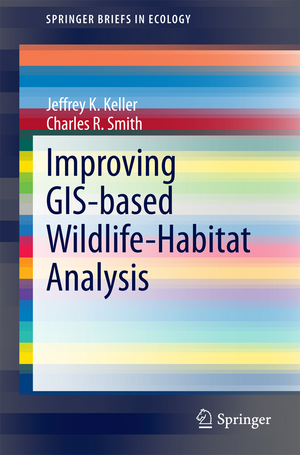Improving GIS-based Wildlife-Habitat Analysis: SpringerBriefs in Ecology
Autor Jeffrey K. Keller, Charles R. Smithen Limba Engleză Paperback – 10 oct 2014
Preț: 379.68 lei
Nou
Puncte Express: 570
Preț estimativ în valută:
72.65€ • 76.05$ • 60.47£
72.65€ • 76.05$ • 60.47£
Carte tipărită la comandă
Livrare economică 31 martie-14 aprilie
Preluare comenzi: 021 569.72.76
Specificații
ISBN-13: 9783319096070
ISBN-10: 3319096079
Pagini: 132
Ilustrații: XIII, 132 p. 14 illus., 6 illus. in color.
Dimensiuni: 155 x 235 x 10 mm
Greutate: 0.22 kg
Ediția:2014
Editura: Springer International Publishing
Colecția Springer
Seria SpringerBriefs in Ecology
Locul publicării:Cham, Switzerland
ISBN-10: 3319096079
Pagini: 132
Ilustrații: XIII, 132 p. 14 illus., 6 illus. in color.
Dimensiuni: 155 x 235 x 10 mm
Greutate: 0.22 kg
Ediția:2014
Editura: Springer International Publishing
Colecția Springer
Seria SpringerBriefs in Ecology
Locul publicării:Cham, Switzerland
Public țintă
ResearchCuprins
Chapter 1. Working Definitions.- Chapter 2. Image Resolution vs. Habitat Selection Scale in a Remote Sensing Context.- Chapter 3. Explanatory Variables.- Chapter 4. Landscape Sampling Area vs. Actual Location of Taxonomic Survey.- Chapter 5. Refining Habitat Specificity.- Chapter 6. Example Using High-resolution Imagery and Taxon-specific Variables.
Notă biografică
Jeffrey K. Keller is a professional restoration ecologist. Charles R. Smith is a senior research associate with Cornell’s Department of Natural Resources. He also holds an adjunct associate professorship in the graduate program in biodiversity, conservation, and policy in the Department of Biological Sciences at the State University of New York at Albany.
Caracteristici
Reviews the weaknesses of current GIS-based ecological modeling approaches and offers specific recommendations on how to improve models Introduces and demonstrates several novel covariates that significantly improve the explanatory and predictive power of species-habitat models over those currently published Offers a detailed review of the history and current state of the field Includes supplementary material: sn.pub/extras
























